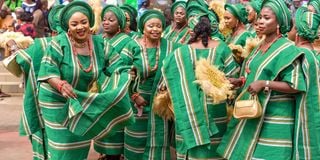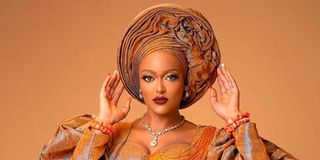Premium
The financial burden of Nigeria’s flamboyant aso ebi dressing style

Women of a similar age group in their aso ebi for attend and event in Southwest Nigeria.
What you need to know:
- The practice has been commodified to the extent that cohesion, equality and social egalitarianism may be taking a back seat.
- Aso ebi is fast becoming a point of dissension, segregating wearers.
- It has a propensity to create social gulfs, distancing wearers and placing them on different tiers of the same ladder.
Aso ebi – “family uniform” – is the Yoruba custom of people dressing alike for social events. The custom is rooted in kinship (ebi), an important aspect of Yoruba social life since precolonial times in what’s now south-west Nigeria.
Words like molebi (kinsmen) and olori ebi (head of the family) point to the importance of kinship in this culture. The saying eni to so ebi e nu, apo iya lo so ko literally translates as “whoever deserts his kinsmen straps on his/her shoulder a satchel of misfortune”. Aso ebi expresses these values visibly: uniform dressing is intended to reinforce unity and fraternity.

Aso ebi – “family uniform” – is the Yoruba custom of people dressing alike for social events. Here men adorn similar attires for an event.
Historically, Yoruba kinsmen wore the aso ebi – usually specially chosen fabrics – during celebrations for group identification.
At first, inclusion and participation in uniform clothing for social events was restricted to blood relationship and mutual ancestry. As time went on, belonging to a group through uniform dressing extended beyond family circles.
From the early 20th century, aso ebi became more about the need to communicate social worth. My interviews with some elderly people in Ibadan revealed that, during this period, it was referred to as ankoo (uniformity) or egbejoda (group uniform). Blood ties became a less important consideration for participation.
Nowadays, aso ebi is a regular feature at social events like weddings, funerals, birthdays, conferments and political rallies across Nigeria.
As a scholar of costume in theatre, I’ve always been fascinated by the aso ebi custom. In theatre, costume helps tell a story, among other functions, and aso ebi is also a costume in the performance of a social event.
I wanted to know more about the modern aso ebi trends. Anecdotal evidence suggested that the practice was becoming something of a burden for some people. My research bore this out: I found that the financial burden of purchasing aso ebi was prominent among its perceived drawbacks and strengths alike.
Aso ebi as costume
In theatre and film, costume transforms actors into characters and depicts setting, culture, age and occupation. It tells the audience something about the character’s social class, economic worth and status in a hierarchy. Costume can project personal characteristics, deliberately or unwittingly. It can help depict relationships in a group.

Labour Party's Presidential candidate Peter Obi (C), flanked by wife Margaret (R) and his running mate Yusuf Datti Baba-Ahmed (L), dons similar attires at a campaign rally in November 2022.
In daily life, too, clothes give us nonverbal clues about their wearers. They reveal age, mood, sex, culture, social status, religion, occupation, political affiliation and so on.
At social events, participants can be regarded as performers as well as audience members. Wearing aso ebi, participants are able to play premeditated or spontaneous roles.
Modern trends
In the last few decades, aso ebi has been embraced by other ethnic groups in Nigeria and the diaspora. The trend has extended beyond the geographical and social landscape of the Yoruba people.
Part of the reason may be its propensity to add glamour and spectacle to events. But even more importantly, it may be due to its inclusion tendency, since it gives wearers a sense of involvement, seemingly excluding some non-wearers, thereby drawing social lines at social events.
It is common for guests to wear identical fabrics like wax prints (Ankara), lace, brocade and other materials to events.

Stacey Moraa wearing Aso oke, a prestigious African outfit hand woven by the Yoruba in Nigeria.
Planning and coordinating this wearing of uniforms at events has become quite a business. Usually, a celebrant chooses the fabric, determines the price and monopolises the sale to guests. Often the intention is to make a profit. Guests can’t haggle over the price and are expected to turn out in the fabric for the event, thereby creating the impression of solidarity and support for the celebrant.
Affordability and social integration have become more significant considerations, pushing kinship to the back seat.
Beyond the glamour, the distress
Despite the popularity of aso ebi, my study found that it is causing some distress.
I administered questionnaires to 270 Yoruba adults (135 men and 135 women) in Osun and Oyo states in south-western Nigeria, asking them about the challenges and merits of wearing aso ebi. Participants indicated whether they experienced any of a list of challenges such as cost, competition and issues of personal taste. The list of potential merits included boosting camaraderie and collective sense of purpose, and benefits to the producers of the uniforms.
The results showed that the main problem with aso ebi was the financial burden of having to buy the fabrics continuously. This stems from being obliged to attend social events and the tendency for reciprocity: “I bought your aso ebi, buy mine.” People end up with a large stock of fabrics and are limited in their ability to buy, store and wear their own clothes.
Another challenge is that buyers of aso ebi fabrics don’t have a choice or the option of bargaining, since it is non-negotiable. And the fabrics and uniforms are not always to the individual’s taste.
Participants also felt that aso ebi encouraged unhealthy flamboyant competition.
When they responded to the list of potential merits, they gave equal weight to aso ebi as a booster of social incorporation and cohesion, and as a source of economic value for individuals who make the fabrics.
The practice has been commodified to the extent that cohesion, equality and social egalitarianism may be taking a back seat. Aso ebi is fast becoming a point of dissension, segregating wearers. It has a propensity to create social gulfs, distancing wearers and placing them on different tiers of the same ladder.
However, according to my study findings, the benefits of aso ebi – like comradeship – still outweigh the challenges.
This article was first published on theconversation.com.





